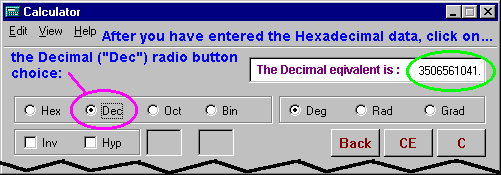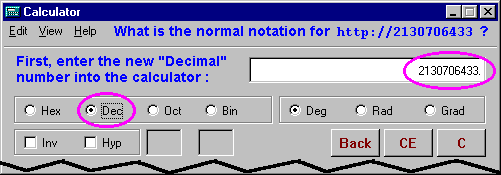"Obscured " IP Numbers ?
or
Why is http://3506561041/
the same as http://209.1.224.17/ ?
Which is the same as
http://geocities.datacellar.net/
( and now also
http://geocities.yahoo.com/home/ )
If you don't have the slightest idea what an IP Number is, you may wish
to skim over my IP (Number) Addressing Schemes
page first.
If you need a thorough introduction to HEXADECIMAL numbers,
then take this link to a page here called: "
What is Hexadecimal ?"
If you take each of the four
octets in the IP Number
209.1.224.17 and convert them to Hexadecimal, you'll
get the following byte-sized numbers:
209 = D1 1 = 01
224 = E0 17 = 11
Placing each of these byte-sized Hex numbers next to each
other in the same order their decimal equivalents were found in the IP
Number will form one large four-byte Hexadecimal number:
D101E011
This is part of the normal process that any Internet communications program
must go through to arrive at the 32-bit string of binary digits which is
actually used to represent this address inside a computer.
However, if we convert this number into decimal instead, we get:
3506561041
This is sometimes referred to as being this URL's "DWord" ( I
don't like using a HEX term to refer to a decimal number, but you'll
see it used this way at other web sites; just think of it as a reference
to the actual DWord stored in your comptuer as " D101E011 ").
( You can use the Calculator in Windows 95/98/NT to do this conversion;
make sure to check the "Scientific" option under the
"View" menu first.)
[ Note: a digital word is
considered to be two 8-bit bytes or 16-bits. Therefore,
the selection
labeled "Dword" (Double-Word)
(see the pic below) refers to four 8-bit bytes or 32-bits.
]

After you've entered the number, select the "Dec" radio button
and the
conversion appears immediately in the white box... You can toggle
back
and forth between the Decimal and Hexadecimal equivalents now.

Let's try doing a conversion in the opposite direction: Suppose we came
across
the obscured IP address of
http://2130706433. Can you
convert this to
it's dotted-decimal form? Enter this Decimal
number into your calculator ...


Well. This number should already look familiar to some of you! The
7F is 127 in decimal, and the zeros and one are quite obvious. So
we have the normal IP address of:
127.0.0.1. This is the IP number reserved for your own
computer and is often referred to as localhost. If you open up
a DOS-Window and type in the command
ping localhost, you'll probably see that it replies with the
line: " Pinging whatever
the name of your computer is [127.0.0.1]
with 32 bytes of data:" ( If it doesn't, then enter
"ping 127.0.0.1" instead on the command line.)
NOTE: you can
ping your own computer even if you are not connected to the Net!
This can be very helpful at times.
I have no idea why such a routine ( using a single decimal
number for an IP ) was created in the first place, but it appears to work
with more Web browsers than just those of Microsoft. At first I thought it
might be a required standard for TCP/IP communications packages since this
also works in all the DOS console commands which are related to the Net;
even the rarely used ftp command! But
I've read that Proxy servers don't allow this! Any further information on
why these types of URLs are allowed by most Net software would be
appreciated.
If you do a ping on 2130706433,
you should see the following (proving it's true for at least this command):

Here's an Internet site which will quickly convert any IP address (from it's
usual dotted-decimal form) to it's equivalent single-decimal
form and vice-versa:
http://www.fichtner.net/tools/ip2dword/. This page does
not appear to be online at this time!
I recently received a SPAM in my email box which used an obscured IP of:
"
http%3a%2f%2f3235415306%2fcheapsite%2f " and so on.
Well, the first thing you need to do is clear things up a bit by converting
the punctuation from HEX to readable characters! Any TWO hexadecimal digits
following a %-sign are simply the ASCII representations of letters
or punctuation marks used on the Net:
3a = :
2f = /
2e = .
20 = blank space
( Look up others on any ASCII chart )
So what we really have here is:
http://3235415306/cheapsite/
etc.
Now you can either use the link above (quicker?) or
your calculator: Set it to DWORD in HEX, switch to DEC and insert the
decimal IP number then switch back to HEX to get:
C0D8850A. This is equivalent to
the normal dotted-decimal representation of:
192.216.133.10. From here you
could use a number of 'whois' lookup tools to find the domain name and who
may own it before complaining to the ISP you got the SPAM from.
If you're really interested in this subject, you have got to visit a Net
friend's page called
"How to Obscure
Any URL -- How Spammers And Scammers Hide and Confuse!" There
are a lot more details on his page!
( I just found out that he independently updated his page a while back with
some pics of the MS-Calculator similar to the ones you saw here! But there
are still enough differences to make studying both of our pages worthwhile
 .)
.)
 Back to The Starman's Index Page.
Back to The Starman's Index Page.





 .)
.)